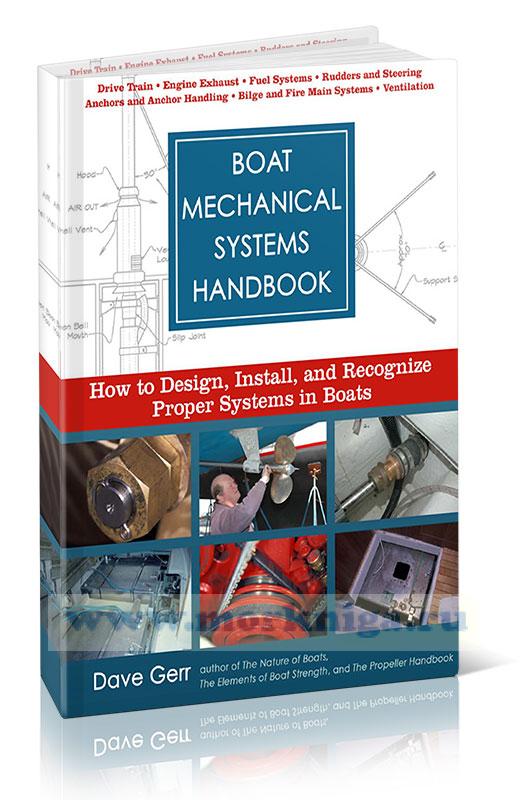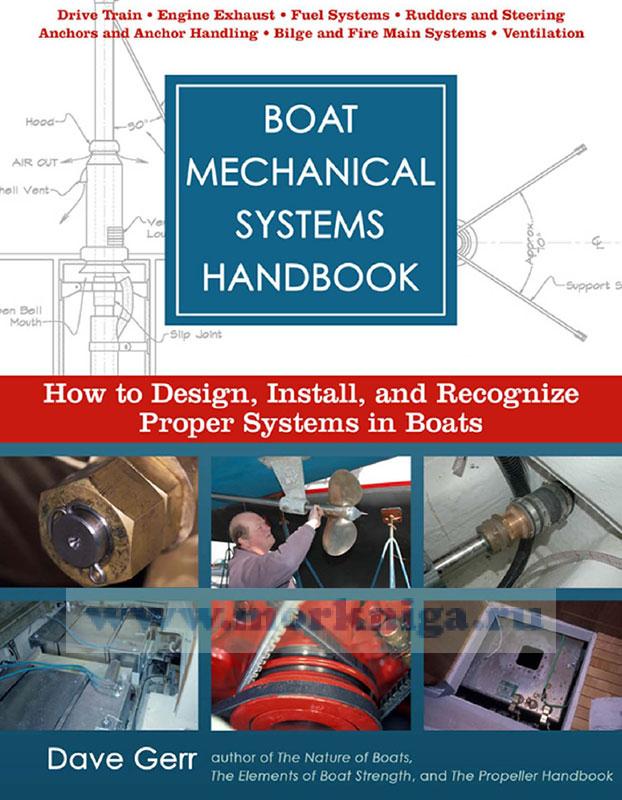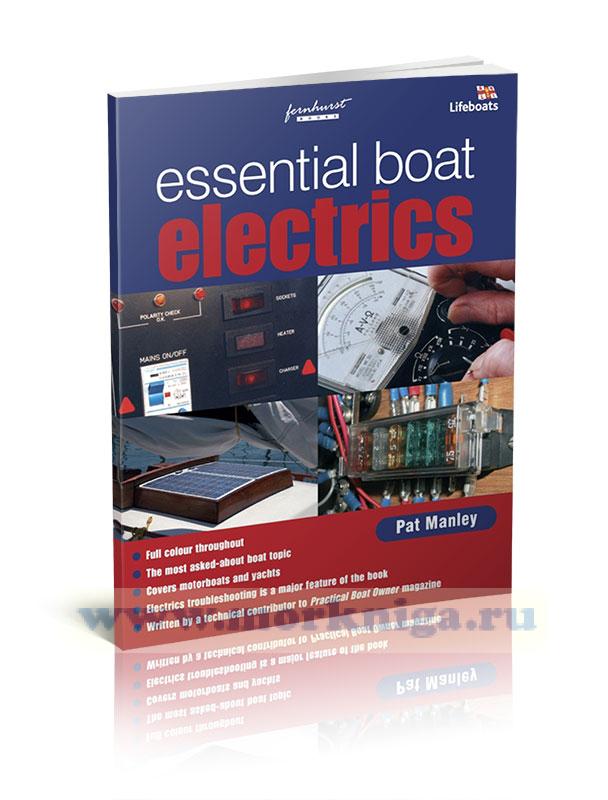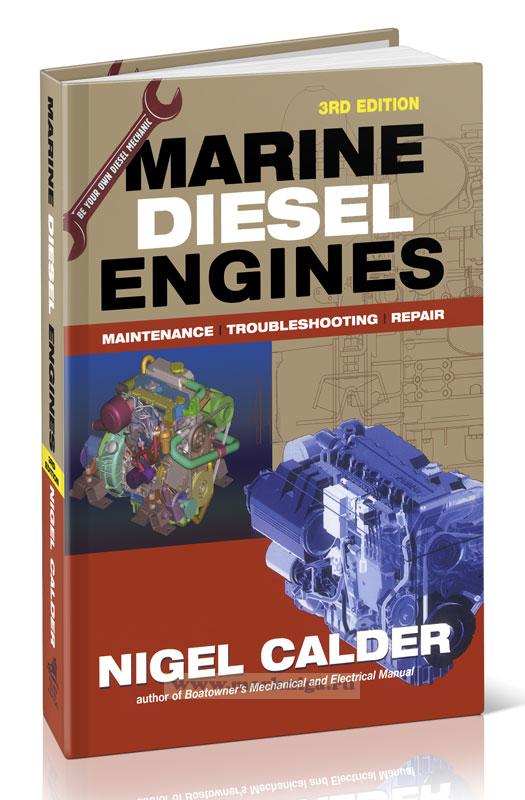Boat mechanical systems handbook. How to design, install, and evaluate mechanical systems in boats/Руководство по механическим системам катеров. Как проектировать, устанавливать и оценивать механические системы в лодках
Издание на английском языке
This guide is invaluable for anyone designing or installing mechanical systems on a new boat, retrofitting an existing boat, or evaluating a boat's operating condition. Writing for designers, builders, owners, buyers, mechanics, surveyors, and insurers of sailboats, powerboats, and commercial vessels, Dave Gerr provides design and installation guidance for each major mechanical system plus pragmatic guidelines and real-world interpretations of American Boat & Yacht Council (ABYC) and European standards. No marine professional or serious boater should be without Boat Mechanical Systems Handbook.
Contents
Lists of Figures, Tables, and Formula
Acknowledgments
Author's Notes
Introduction
Part one. Drivetrain installations
1. Propellers and Shafts
Proper Prop Nuts
Blade Area
Common Causes of Vibration and Noise
Propeller Shafts: Diameter, Bearing Spacing, and Bearings
Shaft Couplings and Keyways
2. Struts, Propeller Apertures, and Shaft Angle
Propeller Struts
Propeller Apertures and Shaft Angle
3. Transmission Geometry, CV Joints, Stuffing Boxes, and Engine Mounts and Beds
Selecting Inboard Transmission Geometry
Part two. Fuel systems
4. Fuel Piping and Fuel System Bonding
Running Pipe
5. Fuel Tanks and Fittings
Hold That Tank
Tank Location
Tank Openings and Penetrations
Tanks Under Pressure
Level Gauging
Tank Materials
6. Tank Capacity and Range: The Free-Surface Effect
Required Tankage for Range
Estimating Cruising-Speed Fuel Consumption
Finding the Capacity of a Tank
Part three. Exhaust systems
7. Wet Exhaust Systems
Breathing Easy
Watering the Exhaust
Support Your Local Exhaust
Make Room for Exhausts
The Low-Engine Exhaust Problem
The "Other" Exhaust Systems
Going Underwater
Avoiding the Silent Killer
Summary of Requirements for a Reliable Wet Exhaust System
Review of Requirements
8. Engine Cooling Systems and Their Exhausts
Engine Cooling
9. Dry Exhaust Systems
The Basic Drystack Configuration
Drystack Exhaust Trunks
More on Mixing and Matching Exhaust Types
Drystack Versus Wet Exhaust
Part four. Rudders and steering systems
10. Rudder Geometry, Shape, and Size
Putting the Rudder to Work
Types of Rudders
Sizing Up the Rudder
The Rudder in Cross Section and Basic Scantlings
Rudder Profile or Planform
Boat Behavior in Turns
11. Rudder-Stock Size, Construction, and Bearing Specification
Rudder Stock, Bearing Calculations, and Construction
Rudder Bearings and Rudder Ports
Roller Bearings
12. Rudder-Stock Angle, Control, and Installation Considerations
Rudder-Stock Angle and Planing-Boat Rudder Configuration
Steering Systems: Controlling the Rudder
Fluid Power: Hydraulic Steering
Backup Steering Gear: Emergency Steering
Steering Refinements and Installation Considerations
Rudder Installation: Shaft and Propeller Removal
13. Unusual and Special Rudders: High-Lift Rudders
Ring-Form Rudders High-Lift Rudders
Comparing Fishtail and Articulated Rudders (Flap Rudders)
Part five. Ventilation, air-conditioning, and heating
14. Ventilation of Passenger and Storage Areas
Ventilation of Passenger Compartments
Ventilation of Storage Spaces: Forepeak, Lazarette, Lockers
15. Air-Conditioning and Heating with Notes on Refrigeration
Air-Conditioning
Notes on Refrigeration
Cabin Heating
Thoughts on Heating and Air-Conditioning Installations
16. Ventilation of Machinery Spaces
Ventilation for Heaters Ventilation of Engine Spaces
Vent Requirements for Inverters, Converters, and Transformers
Battery Venting and Considerations for LPG (Propane) and CNG
Venting of Gasoline Boats
Part six. Plumbing systems with notes on fire suppression
17. Sea Suction
Seacocks
Hose Clamps, Sea Strainers, and Sharing Seacocks
18. Bilge Systems, Fire Mains, and Fire Extinguishers
Bilge Systems
Thoughts and Recommendations on Bilge Systems for Boats
Fire Mains and Fire Suppression
19. Selecting and Sizing Pumps
Types of Pumps
Understanding Head
Total Apparent Head
Acceptable Flow Speeds
Finding Required Pump Power
Pressure Drop
20. Freshwater Systems
Freshwater Tanks and Water Tank Capacity
Freshwater Supply Piping
Freshwater Delivery Piping
Draining Away-Handling Gray Water
Running Pipe
21. My Favorite Head: Thoughts and Recommendations on Marine Toilets and Installations
My Favorite Head-The Blakes Lavac Toilet
Head Installation Plumbing
Pumping Sludge-Handling Sewage
Types of Marine Toilets (Heads)
Part seven. Anchoring systems
22. Anchoring Systems, Anchor Types, and Anchor Selection
Anchoring Systems
Anchor Types
Anchor Size and Designation
Anchor Selection Recommendations
23. Anchor Rode
Chain
Chain Fittings
Rope
Wire Anchor Rode
24. Sizing the Anchor and Rode and Selecting Anchor-Handling Gear
Sizing the Anchor
Sizing the Rode
Selecting a Windlass
Anchor-Launching Considerations
Chain-Locker Requirements
Snubbing Up
Appendix A. Calculating Areas of Plane Figures
Appendix B. International Pipe Standards and Pipe-Size Tables-Pipe-to-Hose Connections
U.S. ISO Pipe Designations-DN Pipe Sizes
U.S. Pipe Thread Standards
Hose-to-Pipe Size Considerations
Appendix C. Measure and Unit Conversion Tables
Appendix D. Insulation Products and Sources
Bibliography
Index


 Essential Boat Electrics/Основное электрооборудование лодки
Essential Boat Electrics/Основное электрооборудование лодки  Marine Diesel Engines/Судовые дизельные двигатели
Marine Diesel Engines/Судовые дизельные двигатели